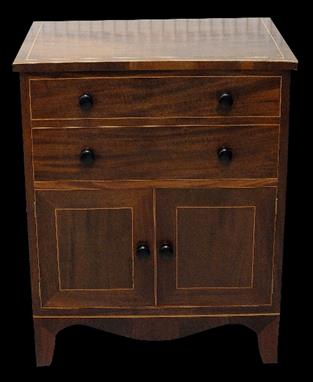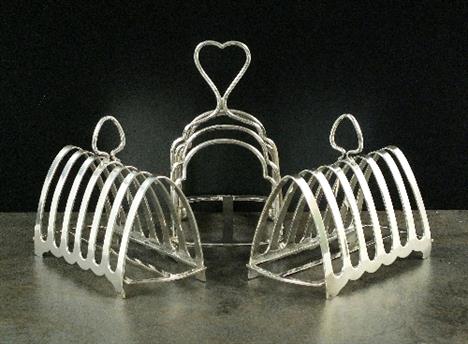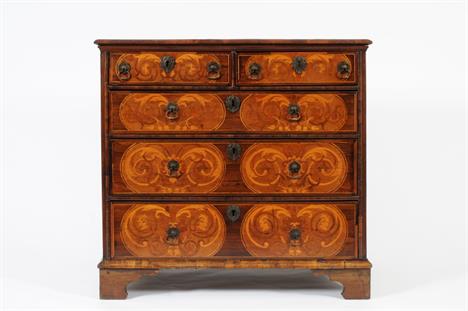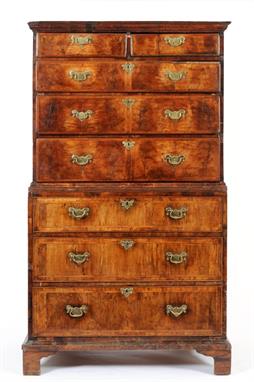177691 Preisdatenbank Los(e) gefunden, die Ihrer Suche entsprechen
177691 Lose gefunden, die zu Ihrer Suche passen. Abonnieren Sie die Preisdatenbank, um sofortigen Zugriff auf alle Dienstleistungen der Preisdatenbank zu haben.
Preisdatenbank abonnieren- Liste
- Galerie
-
177691 Los(e)/Seite
A Goebel Hummel figure, Baking Day, 330, 13 cm high, and eleven others similar (12) Condition report Report by JB The model with the cello displays a High Bee mark 1957. The girl with the birds displays a similar mark. Other models would appear to fall into the 1964/72 bracket See illustrations for details
A pair of Gothic style wall brackets and a light fitting (3) Condition report Report by JB The height of the wall bracket fixed to the wall is 43 cm, and the depth from the front to the wall is 39 cm. One wall bracket has been stripped and re-powdered coated with light signs of rust. The lower section is slightly loose, whereas the other wall bracket is heavily rusted with some home made putty repairs and some loss of detail. The light fitting glass is intact, the wire super-structure is heavily rusted, however intact Please see illustrations for details
An early 19th century mahogany secretaire bookcase, with ebony stringing, having a pair of lancet bar glaze doors above a secretaire drawer, with three further graduated long drawers below, on splay bracket feet, 105 cm wide See illustration Condition report Report by NG Swan neck pediment with losses to veneer. Other losses and split in veneer to cornice. Three moveable shelves behind glazed doors. Some knocks and bumps to sides of doors. Lock to both sides replaced. Several glazed panels repaired. Beading to right side of base at top broken off but present. Inside secretaire drawer - moulding missing and divisions between left back of drawers missing. Marks and stains. Lock probably replaced - has key currently. Handles replaced. Secretaire drawer doesn't close easily Losses to veneer around drawers, and some repaired. Oak drawer linings. Feet worn and damp.
A chest, veneered in walnut, having two short and three graduated long drawers, on bracket feet, 96 cm wide See illustration Condition report Report by JB One large horizontal split running the width of the chest can be observed to the top along with a noticeable amount of wear, scratches, marks and pits to the surface, possibly woodworm. There is also warping present. The top hinges would appear intact. Backboard original but slightly warped and cracked with a noticeable hole and original looking metal plate. Left hand side of the chest worn and marked, again displaying woodworm, suspect dead. Two horizontal splits, both to the top and centre. Right hand side has one horizontal split and again displays woodworm. Drawer handles replaced, majority seem intact. The bottom drawer again displays heavy signs of woodworm, suspect dead. Detail to the bottom worn, chipped and worm ridden with some loss. Same for the feet.
A George III inlaid oak bureau, the fall front above an arrangement of five short drawers and two long drawers, on bracket feet, 97 cm wide Condition report Report by JB Bureau displays general wear that you would expect from age and use. Backboard intact with general markings. General markings, dents, scratches and fading to top section of the bureau, with some loss of veneer decoration to the left hand side. Interior contains multiple drawers and columns, which also work as drawers. Centre detail door noticeably worn and cracking. There are no pigeon holes but there are hidden crevices under the left and right hand side drawer. Some repair can be observed around the hinge section, along with replacements. Leather inset area has been replaced by blue felt. Top section of the drawer outside with general wear, nicks and loss. Noticeable vertical crack to right hand side, some repair to the veneer around detail. Front of bureau displays general wear, more noticeably to veneer detail on the top two sections of drawers, otherwise scratches range from light to deep and some dents to bottom drawer. Handles have been replaced. Drawers would appear to be in working order. Feet and base sections display general signs of wear that you would expect from age and use. Please see photos.
A 19th century mahogany chest, of four graduated long drawers, on bracket feet, 93 cm wide Condition report Report by JB No visible water splatter to the top of the drawers, marks ranging from light to deep, combined with scratches. It would appear the rear section of the top surface has been restored and there are some light horizontal splits forming on the bottom right corner. Backboard replaced at some point. The left hand side of the chest has a split forming down the join running the length of the chest. Same for the right hand side. Handles replaced. Base of drawer linings starting to split and some as though they have been paired. Front of the chest displays general wear and some slight fading on certain drawers.
A George III mahogany chest, of two short and three graduated long drawers, on bracket feet, 96 cm wide See illustration Condition report General markings to the surface, including scratches and surface dents ranging from light to deep. A horizontal split can be seen running diagonally across the front, along with two noticeably dark patches. Right hand side of the chest also displays general markings, including scratches and dents ranging from light to deep. Two vertical splits can be observed, one running the length of the chest, the other approx. a quarter of the way up. The left hand side is in similar order with a split running the full length and a small patch of restoration near the bottom. Handles have been replaced. Front of chest displays general wear and tear. Some light water stains running down the two centre drawers around the lock area. Lock escutcheon has been bent outwards on two regions. Feet reasonably worn with general wear that you would expect from age and use.
Miniature 19th Century Mahogany 3 Drawer Chest with Bracket Feet. Possibly a Salesman`s Sample. Dovetail Draw Construction with Hand Planed and Chamfered Bottoms, Retain`s it`s Original Hardware. Good to Very Good Condition. Measures 12-1/8 Inches Tall by 11-1/2 Inches Long and 6-1/4 Inches Wide. Shipping $68.00 Starting Price: $150.00
A canteen of Victorian Old English pattern silver cutlery, George Adams for Chawner & Co, London 1876, comprising; twelve tablespoons, twelve table forks, twelve dessert spoons and twelve dessert forks, together with a matched pair of silver sauce ladles, Sheffield and twelve silver teaspoons, London, twelve silver plated egg spoons, twelve ivorine handled table knives, twelve ivorine handled side knives, a pair of plated fish servers, a steel and two pairs of ivorine handled serving knives and forks, all presented within later mahogany cupboard canteen with four bracket feet and turned wood handles, total weight of silver approx 98oz
A George IV silver cruet stand, H*, London 1823, the stand of circular form with gadrooned border and scroll and berry cast decorative loop handle, housing seven cruets, comprising; four glass oil/vinegar bottles with glass stoppers, a silver mounted mustard and two silver mounted salt shakers, the stand raised on four scroll bracket feet, 21.5cm high (glass bottles with chips), total weighable silver 22oz
A large Victorian silver salver, Edward, Edward junior, John & William Barnard, London 1843, engraved to the centre; 'Presented at the Anniversary Festival of the Herefordshire Society...21st May 1844', within floral and scroll engraved border, the pie crust rim with scroll and foliate decoration, all raised on four scroll moulded bracket feet, 48.5cm diameter, weight 93.2oz
A near pair of six division silver toast racks, S Blanckensee & Sons, Chester & Birmingham 1934, each of arched form with loop handle and raised on four bracket feet, 9.5cm high, together with a further silver toast rack, Walker & Hall, Sheffield 1928, of four division form with heart loop handle and raised on four ball feet, 12.5cm high, total weight 12.5oz (3)
A large silver plated epergne, the column naturalistically modelled as an oak tree issuing three removable candelabra branches, column terminating in moulded branches to house a glass bowl (lacking bowl), the tree with cast oak leaves and acorns with climbing ivy to the base, all raised upon spreading circular base with engraved coat of arms and oak leaf and acorn cast border tapering to three bracket feet, 59cm high
Johnson, London, a Regency mahogany bracket clock:, the earlier eight-day duration, double fusee movement striking the hours on a bell with an anchor escapement and a fully engraved backplate of floral & rococo decoration, the round convex painted dial having black Roman numerals, blued steel moon hands and signed Johnson, London, the associated mahogany case having cut brass inlay and applied carved decoration to the front, brass fretwork and carrying handles to the sides with a `dutch barn` top, height: 44cm.
George Grove, London, a mahogany bracket clock:, the eight-day duration, five pillar double-fusee movement striking the hours and half hours on a bell, the backplate with engraved border decoration and signed Geor. Grove, London, the eight-inch round convex painted dial with black Roman numerals, blued steel tulip hands and signed George Grove, Wood St, Cheapside, London, the dome topped mahogany case with inlaid stringing to the front, brass fishscale frets to the sides and standing on brass ball feet, height: 42 cm. * Biography George Grove is recorded as working in Wood Street from circa 1809 until his death in 1814. He was the son of the maker Richard Grove of the same address, a Freeman of the Clockmaker`s Company from 1760 until 1817.
Benjamin Jonas, Plymouth, a William IV mahogany bracket clock:, the eight-day duration, double fusee, five-pillar movement striking the hours on a bell, with border engraving to the backplate and pendulum bob, the painted eight-inch round convex dial with black Roman numerals, decorative blued steel hands and signed B. Jonas, Plymouth, the mahogany case with gadrooned pediment top surmounted by a wood and brass ball finial, with further ribbed moulding to the top, bottom and corners of the case, with cast brass floral and ring handles to the sides and brass fishscale frets, standing on gadrooned ball feet, height: 48cm. * Biography Benjamin Jonas is recorded as working in James Street, Plymouth Dock from circa 1812 and married Ann Ezekiel, sister of the Exeter engraver E.A. Ezekiel of whom he was named as a trustee of his will in September 1806. Interestingly a Philip Ezekiel is known to be working in Plymouth Dock in the same period.
A mid- Victorian bracket clock: having an eight-day duration, fusee timepiece movement, the round, white painted dial with black Roman numerals and blued steel clover hands, the curved top mahogany case with carved decoration below the top moulding and to the scroll sides, with a brass-edged inset panel to the base, standing on bun feet, height: 33cm.
Thos. Smith, London, a bell-top bracket clock: having an eight-day duration, five pillar, double fusee movement with a verge escapement, fully engraved backplate with c-scroll decoration and striking the hours on a bell, the arched brass dial having a raised silvered chapter ring engraved with black Roman numerals, Arabic five-minute markings, a matted centre with a subsidiary seconds dial and date aperture, with an inset silvered nameplate engraved Thos. Smith, London, with cast brass c-scroll spandrels to the four corners and blued steel hands, the arch with a subsidiary dial for strike/silent and further c-scroll spandrels, the fruitwood bell-top case with traces of ebonising, wood fretwork to the top corners, glazed side panels, surmounted by a brass carrying handle and standing on brass bracket feet, height: 51cm (handle up) Complete with wall bracket. * Biography There are a number of maker`s named Thomas Smith working in London during this period with the maker of this clock possibly the Thomas working in Princes Street, Aldgate having been apprenticed in 1763, or the Thomas known working in Kirby Street circa 1774.
Henry Beard, Bristol, a mahogany longcase clock:, the eight-day duration movement striking on a bell, with the twelve-inch painted arched dial, with black Roman numerals, floral decoration painted to the four corners, a subsidiary seconds dial and date aperture to the centre, blued steel hands and a moonphase disc set within the arch, signed by the maker Beard, Bristol`, the false plate to the dial is signed by the dialmakers `Walker & Hughes, Birmingham`, the mahogany case of typical Bristol form, with a swan-neck pediment and fluted pillars to the hood, wavy moulding to the inner aspect of the hood door, canted corners to the trunk, inlaid stringing decoration to the base and trunk door, standing on bracket feet. Height: 220cm. * Biography Henry Beard, born 1795, is recorded as working at 5, St John Street, Bristol from before 1836, and known to have been living at this address in 1851. He was the son of the carpenter William Beard and apprenticed to Thomas Palmer, jeweller on the 29th of August 1805, so presumably was free seven years later in 1812. Walker & Hughes were well-known makers of painted clock dials working in Birmingham from 1812 until 1835 when the partnership ended.
John Mends, Plymouth, a late 18th Century oak longcase clock:, the eight-day duration movement striking the hours on a bell, with the twelve-inch arched brass dial having a raised chapter ring engraved with black Roman numerals and outer Arabic five minute markings, the matted centre with a large date aperture and a shaped plaque engraved with the maker`s name John Mends, Plymouth, with blued steel hands and shell cast brass spandrels to the four corners, the arch with a round convex boss engraved with a depiction of an eagle with dolphin spandrels either side, the oak and mahogany case having quartered fluted columns to the trunk with brass capitals, mahogany crossbanding to the door and base, further mahogany panels above and below the door, the hood having fluted columns with cast brass capitals and a swan neck pediment, all standing on bracket feet, height: 223cm. * Biography John Mends is recorded working as both a clock and watchmaker in Plymouth, Devon. He took out a licence on the 7th of May 1767 to marry Mary Clements of Stoke Damerel.
Jas. Lawson, Stirling, a mahogany longcase clock:, the eight-day duration movement striking the hours on a gong, the thirteen-inch round brass dial engraved with black Roman hour numerals, decorative half-hour markings, date and seconds subsidiary dials, tulip engraving to the centre and signed Jas. Lawson, Stirling, with decorative blued steel hands, the mahogany case with an arched top, fluted canted corners to the hood, fluted quartered columns to the trunk inlaid with shell decoration to an oval on the trunk door and with boxwood stringing to the case, with crossbanding to the base and standing on bracket feet, height: 206cm.
John Martin, Bristol a moonphase longcase clock:, the eight-day duration movement striking the hours on a bell, the twelve-inch arched brass dial having a raised chapter ring engraved with black Roman numerals, fleur-de-lys half-hour markings, diamond half-quarter markings and signed either side of VI o`clock John Martin, Bristol, the matted centre having a subsidiary seconds dial, date aperture with wheatear border engraving, the moonphase aperture to the arch with a silvered plate above engraved High water at Bristol Key, with cast brass urn spandrels to the four corners and arch, the blued steel hands now painted gold, the mahogany case with barley twist columns to the trunk and hood, a wavy moulding to the hood door, cresting to the hood and an inset panel with moulded edges to the base, standing on bracket feet, height: 214cm. * Biography John Martin is recorded as working in St Ewans Parish, Bristol becoming a Burgess in 1714 and voting in the Parliamentary elections of both 1722 and 1734. He had a number of apprentices, including Henry Hellier of Chipping Sodbury who joined him in February of 1719 and Thomas Bayley in May 1724 at a premium of ten guineas.
An 18th Century oak and mahogany crossbanded housekeeper`s cupboard:, the upper part with a moulded cornice, having fixed shelves enclosed by two pairs of fielded panel doors, the lower part containing seven short drawers about a central cupboard fitted with six further small drawers and enclosed by a shaped and moulded fielded panel door, flanked by fluted quarter columns with brass mounted Corinthian capitals, on bracket feet, 237.5cm (7ft 9 1/2in) wide, 213cm (7ft) high.
An early 18th Century walnut veneer and feather strung kneehole desk:, the top with a moulded edge and rounded corners, fitted with a single long and six short drawers about a central recessed enclosed cupboard with apron drawer above, on bracket feet, 73.5cm (2ft 5in) wide (some re-veneering).
An early 18th Century walnut and marquetry rectangular chest:, bordered with sycamore lines, the quarter veneered and crossbanded top with a moulded edge, containing two short and three long drawers with foliate scroll decoration in oval reserves, the crossbanded sides decorated with geometric lines, on later bracket feet (with re-veneering), 94.5cm (3ft 1 1/2in) wide. * Provenance Sir William and Lady Bulmer, Hanlith Hall, North Yorkshire.
An 18th Century walnut and crossbanded bureau:, the sloping hinged fall enclosing a graduated shaped fitted interior with ogee pointed pigeon holes and block fronted small drawers, having a well with sliding cover, containing two short and two long drawers below, on ogee bracket feet, 98cm (3ft 2 1/2in) wide. * Provenance Sir William and Lady Bulmer, Hanlith Hall, North Yorkshire.
A walnut secretaire kneehole desk:, with cabinet above, the upper part with a moulded cornice enclosed by a pair of crossbanded arcaded doors, the lower part having a fall enclosing a fitted interior with small drawers, pigeon holes and tooled leather inset writing surface, the recessed central cupboard enclosed by a panel door with shaped apron drawer above, flanked by three short crossbanded drawers to either side, on bracket feet. 82cm (2ft 8 1/4in) wide, 190cm (6ft 2 3/4in) high. * Provenance Sir William and Lady Bulmer, Hanlith Hall, North Yorkshire.
An early 18th Century walnut and feather banded tallboy:, the upper part with a moulded cornice, containing two short and three long drawers, the lower part containing three long cross and feather banded drawers, having crossbanded sides, on later bracket feet, 102cm (3ft 4in) wide), 172cm (5ft 7 3/4in) high.
A George III mahogany linen press:, the upper part with a moulded dentil cornice fitted with sliding trays and enclosed by a pair of recessed cartouche shaped moulded panel doors, the lower part containing two short and a single long drawer, on ogee bracket feet, 132cm (4ft 4in) wide, 184cm (6ft 0 1/2in) high. Sale Date 24th October Illustration charge £40
Shapland & Petter, Barnstaple - An Arts & Crafts oak bookcase:, the overhanging slatted upper section inset with a moulded compressed paper panel entitled `The Village Band`, a pair of glazed sliding doors and a pair of panelled doors below and on shaped bracket feet, 109cm (3ft 7in), wide, 142cm (4ft 8in) high, the lock impressed S & P B. *Notes Exhibited Barnstaple Museum 2005.
An Edwardian mahogany breakfront library bookcase:, the upper part with a moulded cornice, enclosed by two pairs of glazed panel doors, the lower part containing four short frieze drawers and enclosed by two pairs of fielded panel doors below, on bracket feet, 268cm (8ft 9 1/2in) long, 245cm (8ft 0 1/2in) high.
A 19th Century French mahogany secretaire a abbatant:, surmounted by a panel of green variegated marble, having a moulded cornice and carved frieze with leaf and berry ornament, fitted with a frieze drawer, the octagonal panelled hinged fall enclosing a shaped and boxwood strung architectural fitted interior in mahogany and burr maple with an arrangement of drawers about a central enclosed stepped and columned cupboard, containing three long drawers below, on bracket feet, 117cm (3ft 10in) wide, 153cm (5ft 0 1/4in) high.
A George III mahogany and cheveron banded bureau bookcase, circa 1780, moulded cornice above a pair of astragal glazed doors, opening to adjustable shelves, fall opening to small drawers, pigeon holes and central cupboard, four long graduated drawers and bracket feet, 221cm high, 107cm wide, 55cm deep
A Regency brass inlaid ebonised bracket clock, Wyatt, London, early 19th century, the five pillar twin fusee movement with anchor escapement, shouldered plates and striking the hour on a bell mounted on the backplate, the 5.75 inch square single sheet silvered brass Roman numeral dial signed WYATT, South Audley Street, London to centre, with fine heart pierced blued steel hands and foliate scroll engraved decoration to spandrels, the case with brass basket of flowers cast finial to the shallow gadroon carved cushion caddy resting on shallow stepped upstand above front with silvered brass angled fillet to glazed front door flanked by brass strip inset canted angles over apron now inlaid with foliate scroll motif, the sides with cast lions mask ring handles above rectangular brass sound frets, on moulded skirt base with compressed bun feet, 38cm (15ins) high. Henry Wyatt is recorded in Loomes, Brian Watchmakers & Clockmakers of the World, Volume 2 as working in London in 1839, other records indicate that he was 55 years old in 1841 and shared the premises in South Audley Street with his family including his successor, John aged 19 years.
A Scottish William IV figured mahogany eight-day longcase clock, circa 1830, the four pillar rack and bell striking movement with 13 inch circular white painted Roman numeral dial with subsidiary seconds and calendar dials and bearing signature W. ROBERTSON, FORFAR to centre, the case with ball finials to the shaped pediment above circular cushion moulded hinged glazed bezel flanked by rounded angles to hood, the trunk with shallow-arch crossbanded caddy-moulded doors flanked by conforming canted angles, on plain plinth base incorporating integral bracket feet with shaped apron between, 218cm (86ins) high overall.
-
177691 Los(e)/Seite

























































